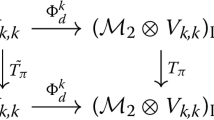Abstract
In this paper, it is shown that Dirac’s Hamiltonian and Bogoliubov’s Hamiltonian both can be braid group matrix representations which are new type of four-dimensional matrix representation of the braid group in comparison with the well-known type (Ge et al. in Int J Mod Phys A 6:3735, 1991; Ge et al. in J Phys A 24:2679, 1991; Ge and Xue in Phys Lett A 152:266, 1991; Ge et al. J Phys A 25:L807 1992) related to the usual spin models. The Dirac’s Hamiltonian is for a free electron with mass m while the Bogoliubov’s Hamiltonian is for quasiparticles in \(^{3}He\)-B with the same free energy and mass being \(\frac{m}{2}\) which depends on the momentum p. And this type is known that the braid matrices are related to the anyon description for FQHE with \(\nu =\frac{1}{2}\) (Nayak et al. in Rev Mod Phys 80, 2008; Slingerland and Bais in Nucl Phys B 612:229, 2001), this may mean that Dirac particle could be decomposed into anyons based on the braid group relation. We also get the Temperley-Lieb matrix representations corresponding to the braid group matrix representations and investigate the entanglement and Berry phase of the corresponding Dirac system.
Similar content being viewed by others
References
Ge, M.L., Wu, Y.S., Xue, K.: Explict trigonometric Yang-Baxterization. Int. J. Mod. Phys. A 6, 3735 (1991)
Ge, M.L., Liu, G.C., Xue, K.: New solutions of Yang-Baxter equation: Birman-Wenzl algebra and quantum group structures. J. Phys. A 24, 2679 (1991)
Ge, M.L., Xue, K.: Rational Yang-Baxterization of braid group representations. Phys. Lett. A 152, 266 (1991)
Ge, M.L., Wu, A.C.T.: Quantum groups constructed from the nonstandard braid group representations in the Faddeev-Reshetikhin-Takhtajan approach. J. Phys. A 25, L807 (1992)
Nayak, C., Simon, S. H., Stern, A., Freedman, M., Sarma, S. D. Non-Abelian anyons and topological quantum computation. Rev. Mod. Phys. 80, 1083–1159 (2008)
Slingerland, J.K., Bais, F.A.: Quantum groups and nonabelian braiding in quantum hall systems. Nucl. Phys. B 612, 229 (2001)
Prasolov, V.V., Sossinsky, A.B.: Knots, Links, Braids and 3-Manifolds. Am. Math. Soc.-Transl. Math. Monogr. 154, 1–237 (1997)
Akutsu, Y., Deguchi, T., Wadati, M.: The Yang-Baxter relation: a new tool for knot theory. In: Yang. C.N., Ge, M.L. (eds) Braid Group, Knot Theory and Statistical Mechanics, p. 151. World Scientific Publ Co Ltd, Singapore (1989)
Dye, H.A.: Unitary solutions to the Yang-Baxter equation in dimension four. Quant. Inf. Process. 2, 117–150 (2003)
Kauffman, L.H., Lomonaco, S.J., Jr.: Braiding operators are universal quantum gates. New J. Phys. 6, 134 (2004)
Zhang, Y., Kauffman, L.H., Ge, M.L.: Yang-Baxterization, Universal quantum Gate and Hamiltonians. Quantum Inf. Process. 4, 159–197 (2005)
Franko, J., Rowell, E.C., Wang, Z.: Extraspecial 2-groups and images of braid group representations. J. Knot Theory Ramif. 15, 413–428 (2006)
Dong, H., Xu, D.-Z., Huang, J.-F., Sun, C.-P.: Coherent excitation transfer via the dark-state channel in a bionic system. Light: Sci. Appl. (2012) 1, e2 doi:10.1038/lsa.2012.2
Nielsen, M., Chuang, I.: Quantum Computation and Quantum Information. Cambridge University Press, Cambridge (1999)
Yang, C.N.: Some exact results for the many-body problem in one dimension with repulsive delta-function interaction. Phys. Rev. Lett. 19, 1312 (1967)
Hosseini, M., Rebić, S., Sparkes, B.M., Twamley, J., Buchler, B.C., Lam, P.K.: Memory-enhanced noiseless cross-phase modulation. Light: Sci. Appl. 1, e40 (2012). doi:10.1038/lsa.2012.40
Baxter, R.J.: Partition function of the eight-vertex lattice model. Ann. Phys. 70, 193–228 (1972)
Zhang, Y., Kauffman, L.H., Ge, M.L.: Universal quantum gate, Yang Baxterization and Hamiltonian. Int. J. Quantum Inf. 3, 669 (2005)
Zhang, Y., Ge, M.L.: GHZ states, almost-complex structure and Yang-Baxter equation. Quantum Inf. Process. 6, 363 (2007)
Zhang, Y., Rowell, E.C., Wu, Y.S., Wang, Z.H., Ge, M.L.: From extraspecial two-groups to GHZ states. e-print quant-ph/0706.1761 (2007)
Chen, J.L., Xue, K., Ge, M.L.: Braiding transformation, entanglement swapping, and Berry phase in entanglement space. Phys. Rev. A. 76, 042324 (2007)
Chen, J.L., Xue, K., Ge, M.L.: Berry phase and quantum criticality in Yang-Baxter systems. Ann. Phys. 323, 2614 (2008)
Temperley, H.N.V., Lieb, E.H.: Relations between the ’Percolation’ and ’Colouring’ problem and other graph-theoretical problems associated with regular planar lattices: some exact results for the ’Percolation’ problem. Proc. R. Soc. Lond. A 322, 251 (1971)
Pasquier, V.: Two-dimensional critical systems labelled by Dynkin diagrams. Nucl. Phys. B 285, 162 (1987)
Pasquier, V.: Lattice derivation of modular invariant partition functions on, the torus. J. Phys. A 20, L1229 (1987)
Andrews, G.E., Baxter, R.J., Forrester, P.J.: Eight-vertex SOS model and generalized Rogers-Ramanujan-type identities. J. Stat. Phys. 35, 193 (1984)
Klümper, A.: New results for q-state vertex models and the pure biquadratic spin-1 hamiltonian. Europhys. Lett. 9, 815 (1989)
Kulish, P.P.: On spin systems related to the temperley-lieb algebra. J. Phys. A: Math. Gen. 36, L489–l493 (2003)
Volovik, G.E.: Exotic Properties of Superfluid \(^{3}He\). World Scientific, Singapore p. 77 (1992)
Xie, B.X., Xue, K., Ge, M.-L.: Bogoliubov’s Hamiltonian as a derivative of Dirac’s Hamiltonian via a braid relation. Phys. Rev. A 77, 064101 (2008)
Yang, C.N.: Communication with W. W. Boone Regarding the Dirac Game (1973)
Nayak, C., Simon, S.H., Stern, A., Freedman, M., Sarma, S.D.: Non-Abelian anyons and topological quantum computation. Rev. Mod. Phys 80, 1083–1159 (2008)
Slingerland, J.K., Bais, F.A.: Quantum groups and nonabelian braiding in quantum Hall systems. Nucl. Phys. B 612, 229 (2001)
Kauffman, L.H.: Knots in Physics. World Scientific Pub. Singapore (1991)
Shankar, R., Mathur, H.: Thomas precession, Berry potential, and the Meron. Phys. Rev. Lett. 73, 1565–1569 (1994)
Wootters, W.K.: Entanglement of formation of an arbitrary state of two qubits. Phys. Rev. Lett. 80, 2245–2248 (1998)
Berry, M.V.: Quantal phase factors accompanying adiabatic changes. Proc. R. Soc. A. 392, 45 (1984)
Acknowledgments
This work was supported by NSF of China (Grants No. 11175043, 11305033) and the Fundamental Research Funds for the Central Universities (Grants No. 11QNJJ012).
Author information
Authors and Affiliations
Corresponding author
Rights and permissions
About this article
Cite this article
Hu, T., Ren, H. & Xue, K. Dirac’s Hamiltonian and Bogoliubov’s Hamiltonian as representation of the braid group. Quantum Inf Process 13, 391–399 (2014). https://doi.org/10.1007/s11128-013-0657-y
Received:
Accepted:
Published:
Issue Date:
DOI: https://doi.org/10.1007/s11128-013-0657-y



